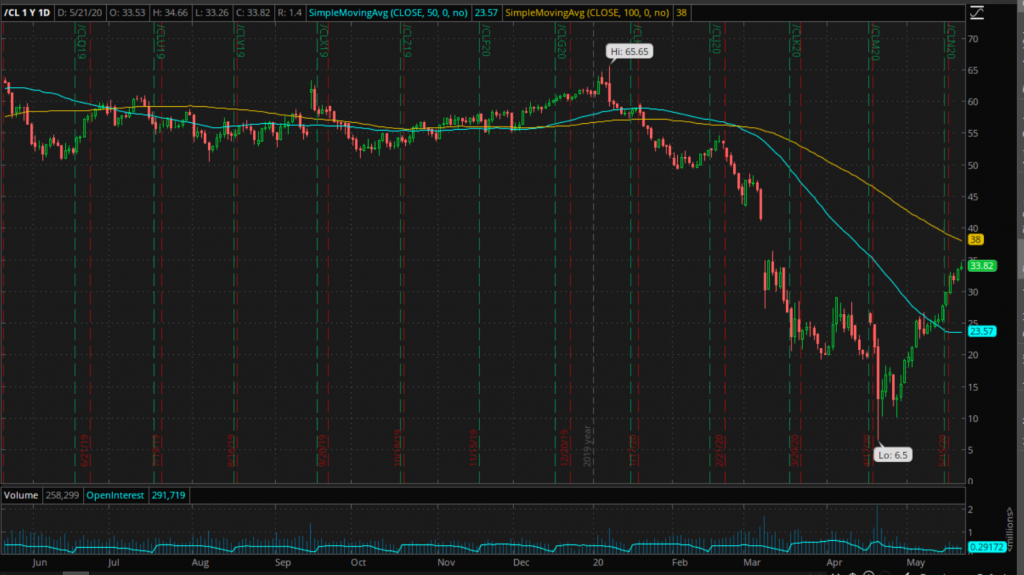Last week, I expressed my view that the strong rally in crude that was underway would falter, and that still scarce storage would force prices lower as the expiration of the front-end futures contract neared.
I was wrong.

I have no problem saying that, although, in the past my tendency to bring attention to bad calls has proven unpopular with publishers, editors and other writers. They believed that bad calls are a fact of life when you give an opinion and, as everyone is aware of that, they can safely be ignored.
To me, though, that is exactly why they cannot.
Whether you trade in the short-term or invest for the long-term there will be times when things just don’t pan out how you envisaged. What matters is that you recognize it, own it, and do something about it. How can I give that advice to people, then attempt to gloss over my own bad calls?
If you do it, then even when your base case for a commodity, stock or whatever is proven wrong, it doesn’t cost you that much. I have said before that discipline is the key to longevity in trading, and this is a good example of why. If you agreed with me last week and decided to short crude, but also followed my basic advice to always set and stick to a stop loss order when initiating a trade, you would have taken a small, manageable loss, then re-evaluated.
When you did that, you might have tried again and taken another small loss, or you might have reversed your view and made money on the rest of the move. Or you might have found yourself unsure and just sat it out for a while. Any of those, though, would enable you to live to fight another day.
The worst thing you could have done, although completely understandable, would have been to ignore the bad news, hang on, and hope it came back. It is understandable because it is human nature to some extent. None of us likes to admit that we were wrong, and we are wired and encouraged to ignore bad news and focus on the good.
To survive and prosper as a trader, however, you have to cut your losses and run your profits. That means doing the exact opposite of what comes naturally, resisting the temptation to ignore a market move against you, and not immediately booking a profit when one is available.
What Happened?
Acknowledging and owning bad calls is one thing, but, as I said, it also involves re-evaluating, and the first stage of that process is to understand what you got wrong.
In this case, I had said a couple of weeks ago that at some point, the reduction in supply from both the increased cuts by OPEC+ and the effects of oil’s collapse on U.S. producers would run into increasing demand as the U.S. re-opened following the coronavirus shutdown and cause a big run up. That happened faster than I envisaged, resulting in a sharp decline in inventories and alleviating the storage shortage.
What Next?
The sustainability of the rally from here will probably be most affected by how quickly the U.S. and world economies get back to something approaching “normal”. So far, that too is happening faster than anticipated.
It seems that in much of the U.S. there is a feeling that the “cure” for coronavirus, the almost complete shutdown of local economies, is turning out to be worse than the disease. With that comes an acceptance that as economies restart, there will be new cases, and even deaths. That is what has happened in some of the states that re-started their economies early, but they are pressing on undeterred.
Ultimately, though, “re-opening” can only happen if people go along with it. There is some evidence that that is happening too. Even in my current home state of Connecticut, which took its first tentative step towards re-opening yesterday, the initial traffic began to pick up again weeks ago, and more traffic means more gas sales and more pull-through of crude.
The question then becomes whether or not supply can be re-instated quickly if demand continues to recover. There is some doubt about that, as evidenced by a quote from the Bloomberg article linked to…
““When you shut in wells, especially for a long period of time, you have a lot of surprises,” Clay Bretches, an executive vice president at Apache Corp., said during a conference call with analysts on Thursday. “Some of them are good and some of them are bad.”
Until we see evidence to the contrary though, we should assume that demand will continue to come back faster than supply, and that means the rally can continue, with the next target level being the 100-day MA at around $38.
Of course, there is a chance that that won’t be the case, but if so, I will once again own it, cut and re-evaluate…
Other News
There are a couple of things I wanted to bring to your attention this week.
First, we here at Deep Earth are launching a new service. If you want some specific trade recommendations and more detailed analysis of individual, actionable trade ideas, you might want to take a look at it.
It is called, Energy Income Trader, and you can find out more by clicking here.
Second, as mentioned in the ad above, I will be part of a panel on Friday, May 22nd at Midday Eastern discussing the state of the markets right now and where the opportunities lie.
If you want to join that presentation, you can click this link at 12 noon tomorrow to join us. I look forward to seeing you.
Cheers,

